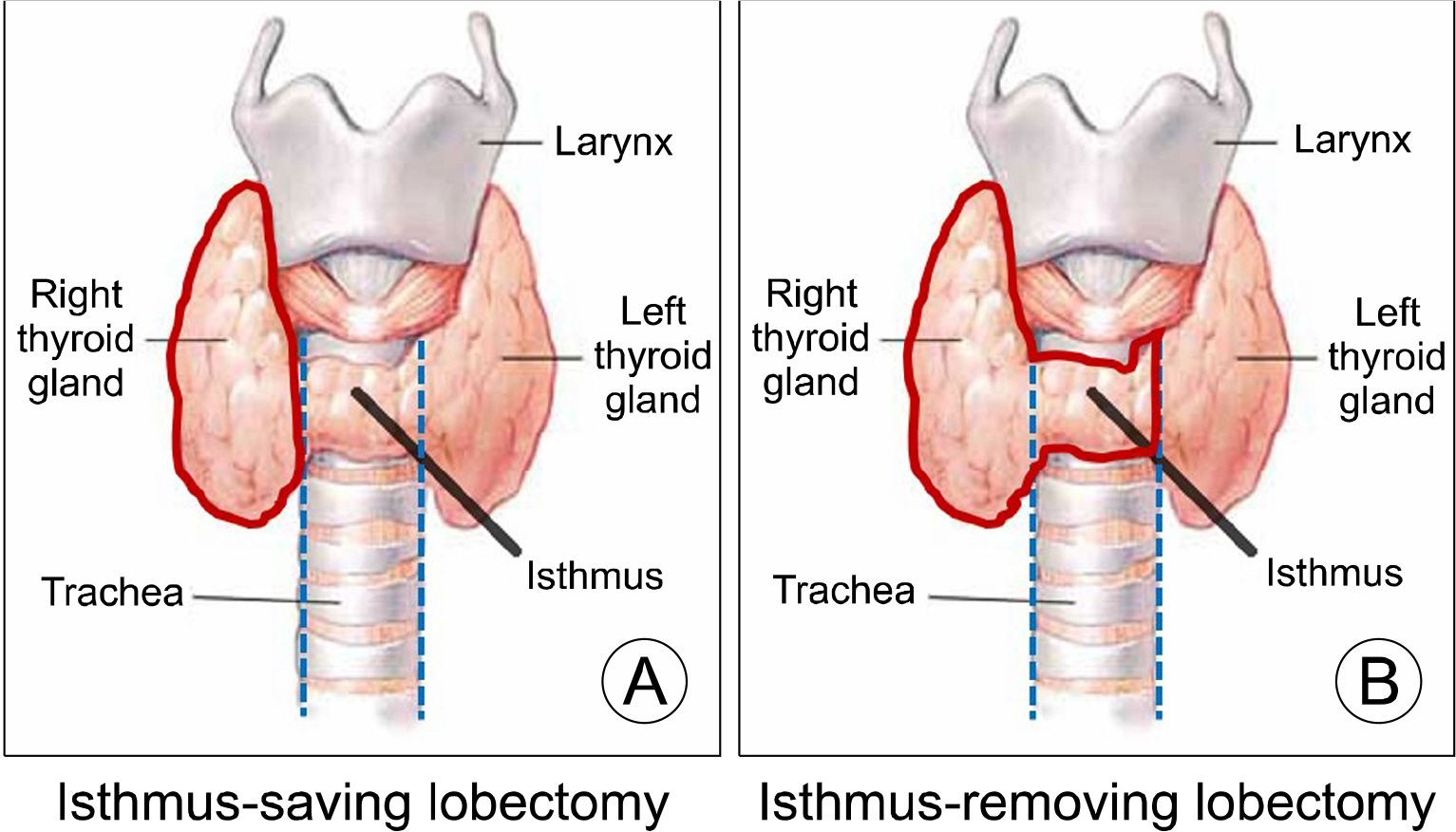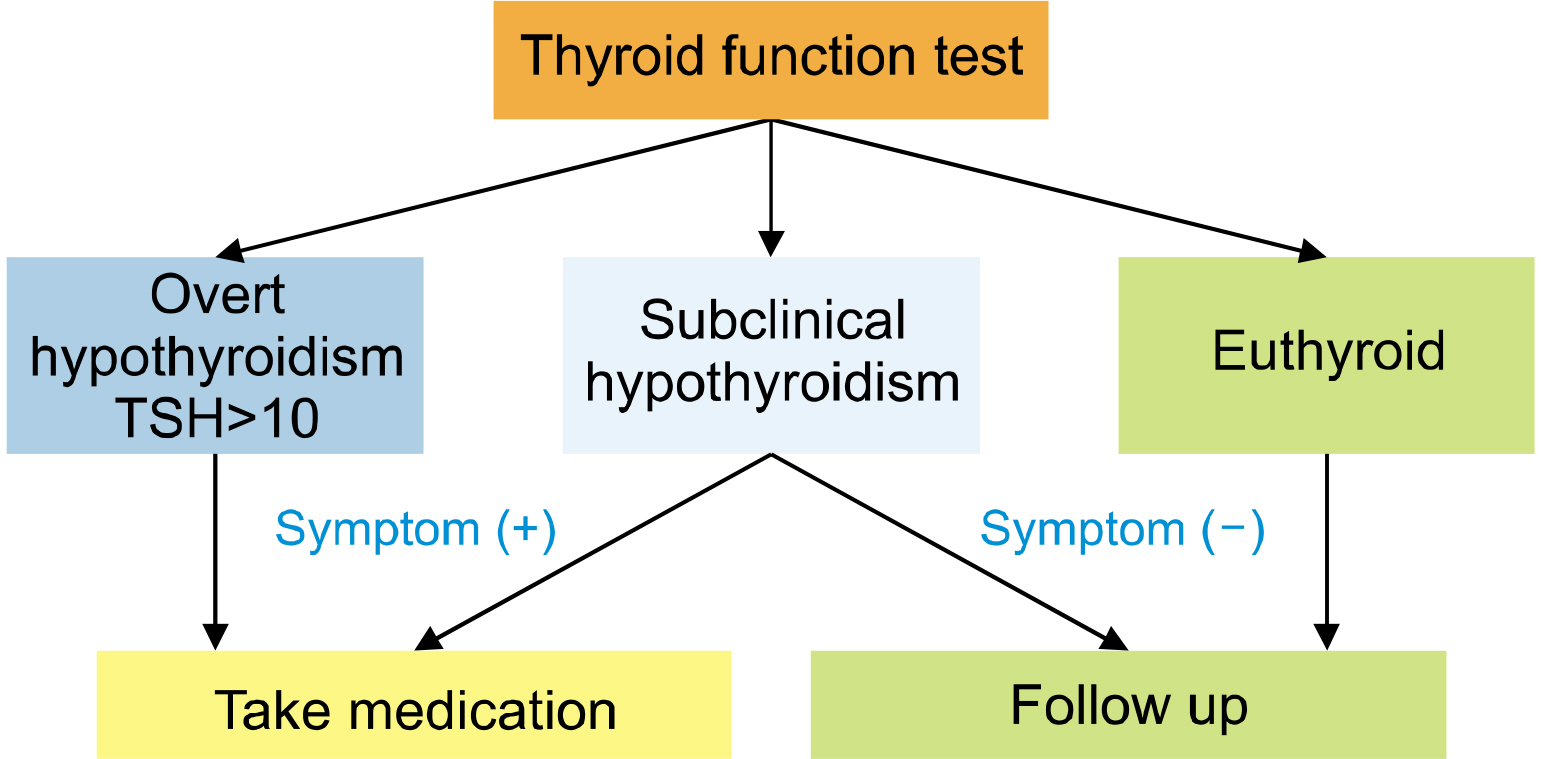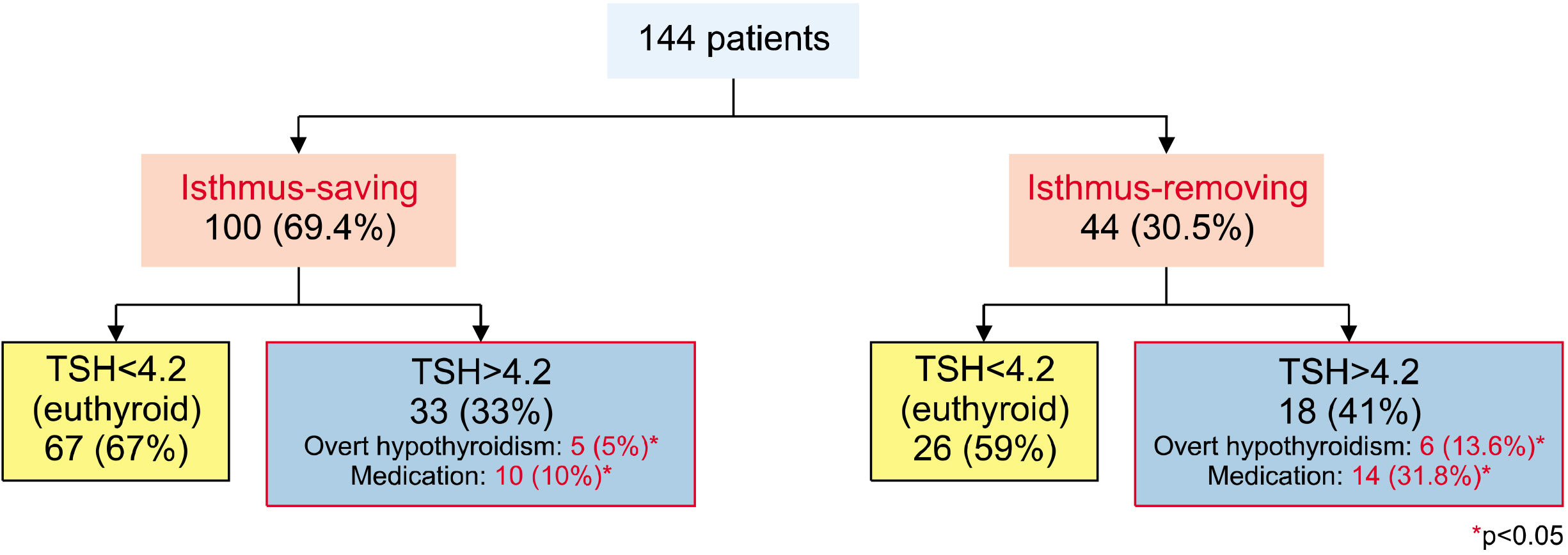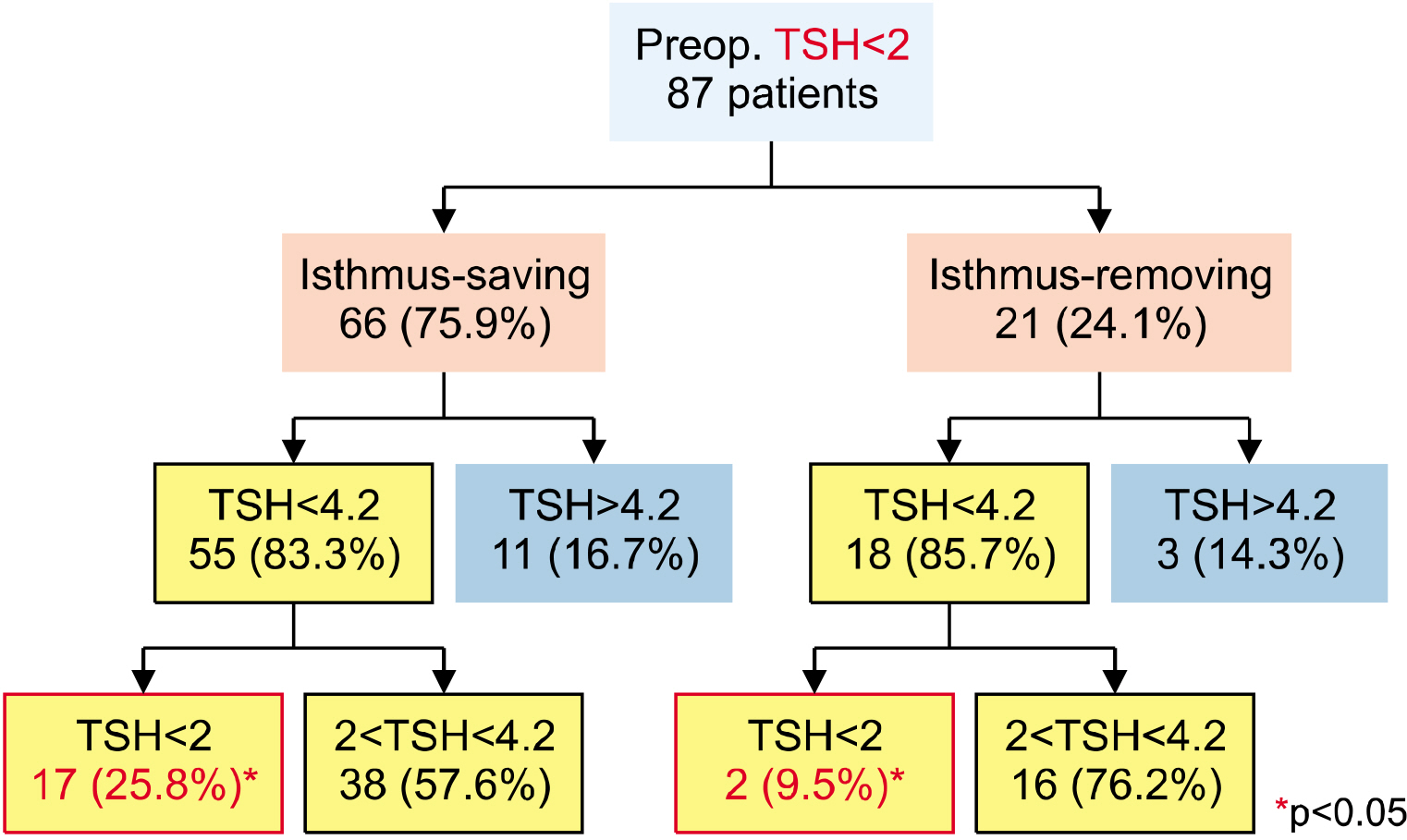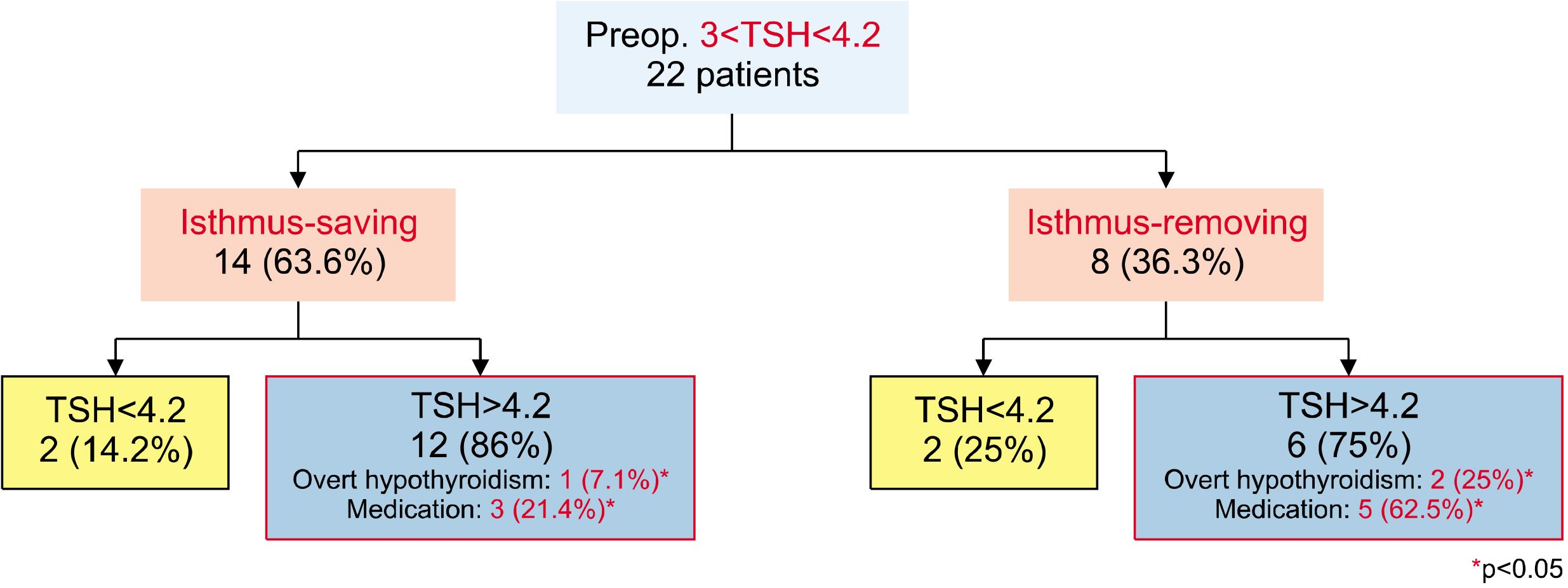Int J Thyroidol.
2023 May;16(1):120-127. 10.11106/ijt.2023.16.1.120.
Effects of Isthmus Preservation on Postoperative Hypothyroidism after Lobectomy
- Affiliations
-
- 1Department of Surgery, Goo Hospital, Daegu, Korea
- 2Department of Surgery, School of Medicine, Kyungpook National University, Daegu, Korea
- KMID: 2543019
- DOI: http://doi.org/10.11106/ijt.2023.16.1.120
Abstract
- Background and Objectives
Many patients experience hypothyroidism after lobectomy. The purpose of this study was to investigate the effects of the extent of surgery (isthmus-saving lobectomy vs. isthmus-removing lobectomy) on postoperative hypothyroidism after lobectomy.
Materials and Methods
In total, 144 consecutive benign or low-risk papillary thyroid cancer patients with euthyroid status were retrospectively enrolled from January 2016 to June 2018; 100 patients underwent isthmus-saving lobectomy (IS group), and 44 patients underwent isthmus-removing lobectomy (IR group). Thyroid function tests (TSH) were performed at 3, 6, 12, and 24 months after surgery. Levothyroxine was administered to patients with overt hypothyroidism and those with subclinical hypothyroidism who complained of obvious symptoms of hypothyroidism.
Results
The TSH level was significantly lower in the IS group at 3 and 6 months after surgery (p=0.049 and 0.026, respectively). Among patients with TSH <2 μIU/mL preoperatively, 17 patients (17/66=25.8%) in the IS group had significantly maintained TSH levels at <2 μIU/mL compared with 2 patients (2/21=9.5%) in the IR group even after surgery (p=0.039). Postoperative overt hypothyroidism was found in 5 patients (5.0%) in the IS group and 6 patients (13.6%) in the IR group (p=0.048), and the numbers of patients who took medication after the surgery, 10 (10%) and 14 (31.8%), were significantly lower in the IS group (p=0.001).
Conclusion
Isthmus-saving lobectomy in patients with euthyroid status reduced the incidence of postoperative hypothyroidism and thyroid hormone replacement and helped in maintaining a low TSH level when compared with isthmus-removing lobectomy.
Keyword
Figure
Reference
-
References
1. Haugen BR, Alexander EK, Bible KC, Doherty GM, Mandel SJ, Nikiforov YE, et al. 2016; 2015 American Thyroid Association management guidelines for adult patients with thyroid nodules and differentiated thyroid cancer: the American Thyroid Association guidelines task force on thyroid nodules and differentiated thyroid cancer. Thyroid. 26(1):1–133. DOI: 10.1089/thy.2015.0020. PMID: 26462967. PMCID: PMC4739132.
Article2. Stoll SJ, Pitt SC, Liu J, Schaefer S, Sippel RS, Chen H. 2009; Thyroid hormone replacement after thyroid lobectomy. Surgery. 146(4):554–8. discussion 8–60. DOI: 10.1016/j.surg.2009.06.026. PMID: 19789012. PMCID: PMC2755641.
Article3. Wilson M, Patel A, Goldner W, Baker J, Sayed Z, Fingeret AL. 2020; Postoperative thyroid hormone supplementation rates following thyroid lobectomy. Am J Surg. 220(5):1169–73. DOI: 10.1016/j.amjsurg.2020.06.052. PMID: 32684294.
Article4. Verloop H, Louwerens M, Schoones JW, Kievit J, Smit JW, Dekkers OM. 2012; Risk of hypothyroidism following hemithyroidectomy: systematic review and meta-analysis of prognostic studies. J Clin Endocrinol Metab. 97(7):2243–55. DOI: 10.1210/jc.2012-1063. PMID: 22511795.
Article5. Lee DY, Seok J, Jeong WJ, Ahn SH. 2015; Prediction of thyroid hormone supplementation after thyroid lobectomy. J Surg Res. 193(1):273–8. DOI: 10.1016/j.jss.2014.07.003. PMID: 25088372.
Article6. Shin HS, Ko JW, Kim JS, Moon DJ. 2011; Risk factors for hypothyroidism after thyroid lobectomy with papillary thyroid carcinoma according to existence of thyroiditis. Korean J Endocr Surg. 11(2):90–6. DOI: 10.16956/kjes.2011.11.2.90.7. Lee MC, Kim MJ, Choi HS, Cho SW, Lee GH, Park YJ, et al. 2019; Postoperative thyroid-stimulating hormone levels did not affect recurrence after thyroid lobectomy in patients with papillary thyroid cancer. Endocrinol Metab (Seoul). 34(2):150–7. DOI: 10.3803/EnM.2019.34.2.150. PMID: 31099202. PMCID: PMC6599911.8. Ahn D, Sohn JH, Jeon JH. 2016; Hypothyroidism following hemithyroidectomy: incidence, risk factors, and clinical characteristics. J Clin Endocrinol Metab. 101(4):1429–36. DOI: 10.1210/jc.2015-3997. PMID: 26900643.9. Tian T, Huang R, Liu B. 2019; Is TSH suppression still necessary in intermediate- and high-risk papillary thyroid cancer patients with pre-ablation stimulated thyroglobulin <1 ng/mL before the first disease assessment? Endocrine. 65(1):149–54. DOI: 10.1007/s12020-019-01914-z. PMID: 30924085.
Article10. Gharib H, Mazzaferri EL. 1998; Thyroxine suppressive therapy in patients with nodular thyroid disease. Ann Intern Med. 128(5):386–94. DOI: 10.7326/0003-4819-128-5-199803010-00008. PMID: 9490600.
Article11. Biondi B, Filetti S, Schlumberger M. 2005; Thyroid-hormone therapy and thyroid cancer: a reassessment. Nat Clin Pract Endocrinol Metab. 1(1):32–40. DOI: 10.1038/ncpendmet0020. PMID: 16929364.
Article12. McHenry CR, Slusarczyk SJ. 2000; Hypothyroidisim following hemithyroidectomy: incidence, risk factors, and management. Surgery. 128(6):994–8. DOI: 10.1067/msy.2000.110242. PMID: 11114634.
Article13. Miller FR, Paulson D, Prihoda TJ, Otto RA. 2006; Risk factors for the development of hypothyroidism after hemithyroidectomy. Arch Otolaryngol Head Neck Surg. 132(1):36–8. DOI: 10.1001/archotol.132.1.36. PMID: 16415427.
Article14. Moon HG, Jung EJ, Park ST, Jung TS, Jeong CY, Ju YT, et al. 2008; Thyrotropin level and thyroid volume for prediction of hypothyroidism following hemithyroidectomy in an Asian patient cohort. World J Surg. 32(11):2503–8. DOI: 10.1007/s00268-008-9717-3. PMID: 18758850.
Article15. Park H, Harries V, McGill MR, Ganly I, Shah JP. 2020; Isthmusectomy in selected patients with well-differentiated thyroid carcinoma. Head Neck. 42(1):43–9. DOI: 10.1002/hed.25968. PMID: 31589005. PMCID: PMC7485011.
Article
- Full Text Links
- Actions
-
Cited
- CITED
-
- Close
- Share
- Similar articles
-
- Changes of Thyroid Function in Patients Undergoing Partial Thyroidectomy for Benign Thyroid Tumors
- Risk Factors for Hypothyroidism after Thyroid Lobectomy with Papillary Thyroid Crcinoma according to Existence of Thyroiditis
- The Predictable Factors of Hypothyroidism Following to Thyroid Lobectomy
- Is it possible to predict hypothyroidism after thyroid lobectomy through thyrotropin, thyroglobulin, anti-thyroglobulin, and anti-microsomal antibody?
- Hypothyroidism

